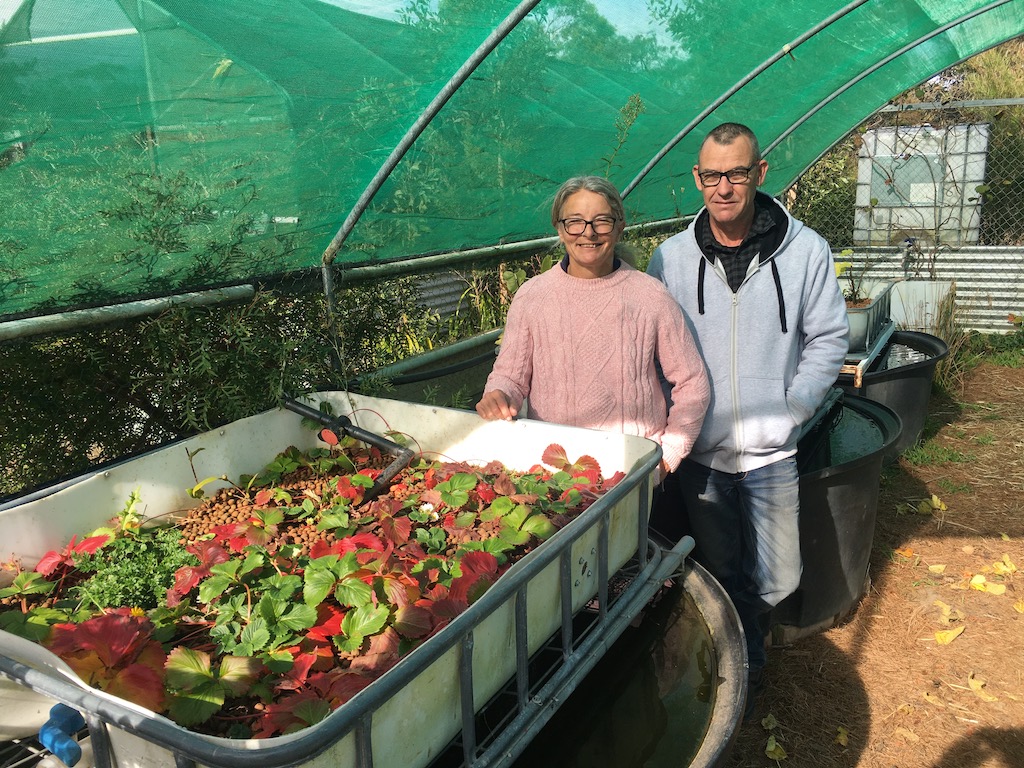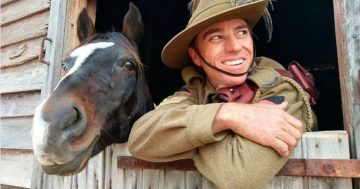
Debbie Hunt and Kieron Malone next to one of their solar-powered aquaponic tanks. They are growing strawberries, fig tree cuttings and grevillea cuttings among a variety of plants. Photo: John Thistleton.
Bungonia would not be many people’s first choice to grow fruit and vegetables. The soil is mostly heavy clay, summer’s heat is extreme, the rainfall is low and winters are below freezing.
When Debbie Hunt and her partner Kieron Malone turned up from the Central Coast on a 25-acre (10-hectare) block near Bungonia to grow their own food, some locals laughed at them.
Undaunted, the couple came with ducks and chooks and determination, keen to put their research, horticultural experience and planning into practice. They dug up extra-large holes that they filled with the chicken poo-enriched mulch gathered from their coops, added worms from their worm farm and three months later, planted fruit trees.
They now have more than 300 trees and harvest more apples and stone fruit than they need. Instead of netting the fruit trees, they have planted wattles nearby because their seeds draw the marauding parrots and cockatoos away from their orchards. They still allow for some losses to the birds. Shade and grow houses built from recycled materials keep out wallabies and rabbits, which had eaten their earlier crops.
As more people come from Sydney and suburbia to live sustainably throughout the Goulburn district, Debbie and Kieron are opening up their property for workshops on how to do it successfully, for minimal costs. (Find out more on the workshops from An Alternative Life Farm.)
“Part of our belief is everyone should be able to grow their own food and it’s not terribly expensive to do it if you set up the right system,” Debbie said. “All our fences, sheds, garden structures, everything has been made out of recycled materials.”
More than a decade after practising what they teach, they have transformed their block into a food bowl, selling excess produce, and hope to broaden that enterprise soon.
“We don’t use a tractor or machinery, it’s all manually done [except for] a ride-on mower and petrol-driven water pump for irrigation,” Debbie said.
They have learned to work with that drought-hardy perennial Sifton bush, the bane of landowners because it comes back harder than ever after slashing or ripping, as was the practice with their block’s previous owners.
The couple is untroubled by Sifton because it harbours insect-eating native birds. But they have replaced a large patch of it with an irrigated orchard covered in a thick mat of native grasses. They achieved this by pulling out by hand the Sifton bush and selectively cutting bigger bushes, which have not returned.
They are growing strawberries and cuttings above three 1000-litre tanks in a successful aquaponics set-up. Their first attempt with silver perch in the water failed when the fish died. Now Koi carp are thriving, as are the plants on the surface.

Tomatoes are ripening and seedlings taking root in a hothouse where Debbie Hunt checks on the progress of plants. Photo: John Thistleton.
Their gardens are full of freshly planted garlic, peas, winter lettuce, winter Asian greens, broccoli, cauliflower and cabbages, onions, carrots, turnips and swedes.
“We have enough pumpkins and garlic in storage [for winter],” Debbie said. “We pick daily from our garden spring onions, lettuce and all sorts of different little bits and pieces … celery, leeks, we still have a store of hazelnuts and are harvesting some raspberries at the moment. We maintain about 80 per cent self-sufficiency.”
Only a small portion of their land is used for growing food. They have allowed the surrounding bushland to regenerate across seven acres (2.8 hectares) that had been strip-cleared. They planted hundreds of casuarina trees for glossy black cockatoos, a threatened species, grevilleas, kangaroo paws and other native plants.
“We were not previously a farm block and in some ways that’s a disadvantage because there is no manure, no anything on the ground,” Debbie said. “The ground was like concrete, but in other ways, it is a real advantage because our property wasn’t loaded with a lot of the weeds you see on past agricultural properties.”
Scrubby under-storey around the garden plots looks unattractive but harbours rare scarlet robins, red-browed finches and other insect-eating woodland birds.
“And the woodland birds are all insect-eating, they don’t eat your fruit, your vegetables, they just eat insects and they are critical to our organic production here on the farm,” Debbie said.








